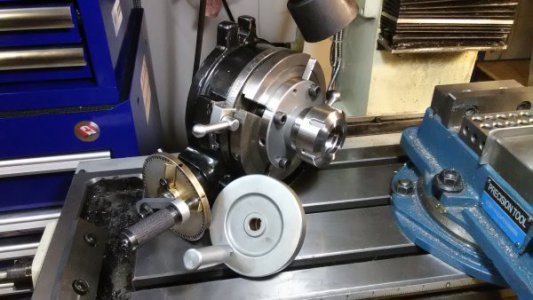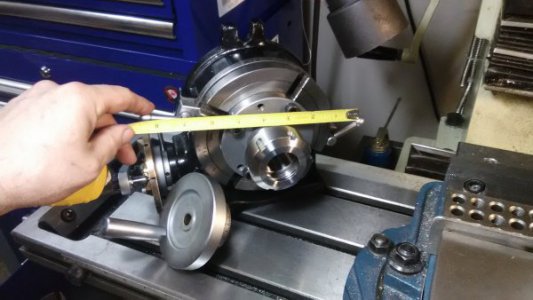Thanks for taking the time to do this. I have yet to try cutting gears and I find it kinda fascinating. Quick question about the ER40 though, why not 5C? I ask because I've been considering a 5c set (collets, blocks, chuck) for the versatility and compatibility even though it's going to be more costly than say an MT3 taper collets to fit in my lathe's spindle but then I can't use them in my indexer etc. Or my mill's ER20 collets but then I can't fit them in my lathe without making sleeves etc. So I thought 5c would be the buy once, cry once deal but I'll use it forever.
-
Welcome back Guest! Did you know you can mentor other members here at H-M? If not, please check out our Relaunch of Hobby Machinist Mentoring Program!
You are using an out of date browser. It may not display this or other websites correctly.
You should upgrade or use an alternative browser.
You should upgrade or use an alternative browser.
Cutting Gears. Diametral
- Thread starter Ray C
- Start date
B
British Steel
Forum Guest
Register Today
Part 3:
Why do gear cutters come in a set for a particular Modulus or Diametral Pitch?
====8< snipetty snip --------
If someone wanted a perfectly matched set of gears for totally optimal operation, a special cutter with a unique involute profile would be needed for each gear with a given number of teeth. -Not practical... and thus, the cutter designers decided on the best trade-offs between performance and practicality and grouped standard cutters into a fixed set.
====8<-------
Ray
Or, a rack-form cutter can generate perfect gears, with enough passes - this is how commercial gears are made, either with a hobber (where the straight-flanked hob and the gear both rotate, the slower the hob pitch/more rotations the more accurate the finished gear) or a gear shaper where a rack-form cutter in something very much like a shaper makes multiple passes as the cutter traverses to match the gear tooth pitch as it rotates, again the finer the traverse and gear rotation the closer to the ideal involute tooth form.
For the finest quality gears, the profiles will be ground on a gear shaper rather than cut - they're things of rare beauty
For those of us working in home shops, the 8-cutter set is the best trade-off albeit a slow one, although it's getting affordable to build a hobber if you already have e.g. a CNC mill and the hobs are pretty simple to make (if your lathe can cut Module / DP pitches).
Dave H. (the other one)
*raises hand* interested in the details/links etcFor those of us working in home shops, the 8-cutter set is the best trade-off albeit a slow one, although it's getting affordable to build a hobber if you already have e.g. a CNC mill and the hobs are pretty simple to make (if your lathe can cut Module / DP pitches).
Dave H. (the other one)
- Joined
- Nov 16, 2012
- Messages
- 5,596
Thanks for taking the time to do this. I have yet to try cutting gears and I find it kinda fascinating. Quick question about the ER40 though, why not 5C? I ask because I've been considering a 5c set (collets, blocks, chuck) for the versatility and compatibility even though it's going to be more costly than say an MT3 taper collets to fit in my lathe's spindle but then I can't use them in my indexer etc. Or my mill's ER20 collets but then I can't fit them in my lathe without making sleeves etc. So I thought 5c would be the buy once, cry once deal but I'll use it forever.
You're welcome and thanks jumping in on the fun...
Why ER40? Man, that's a good question! I had a 4", 3 Jaw chuck on that little rotary table (RT) and it stuck-out really far. When mounted horizontally on the rotary table, it decreased the work envelope of the table. In vertical mode, the mill head had to be cranked-up pretty high. A 5C would have been worse in that regard.
Also, many sets of ER40 collets go up to 1.125" which is the same as 5C.
Honestly though, these are after-thoughts. I just wanted to get rid of the little chuck because it needed to be re-centered on the RT every time I wanted to do a precise setup (3 jaw chucks aren't known for good centering at different diameters). Also, it had a nasty habit of loosening up the jaws from the impacts of gear cutting.
I just naturally gravitated toward the ER40 without really thinking about it. It just seemed like the ideal solution. I'll tell you this... That chuck is now perfectly centered on that RT and I like having that chuck on that RT so much, that I'm NOT taking it off. I'll buy another RT if needed to avoid taking that chuck off there.
FYI:
https://www.ebay.com/itm/ER40-COLLET-12-PC-COMMON-SIZE-1-8-3-16-1-4-5-16-3-8-1-2-5-8-3-4-1-1-1-16-1-1-8/322043652757?ssPageName=STRK:MEBIDX:IT&_trksid=p2057872.m2749.l2649
https://www.ebay.com/itm/New-100MM-DIAMETER-ER-40-COLLET-CHUCK-Compact-Lathe-Tight-Tolerance/112413227062?ssPageName=STRK:MEBIDX:IT&_trksid=p2057872.m2749.l2649
Ray
- Joined
- Nov 16, 2012
- Messages
- 5,596
Or, a rack-form cutter can generate perfect gears, with enough passes - this is how commercial gears are made, either with a hobber (where the straight-flanked hob and the gear both rotate, the slower the hob pitch/more rotations the more accurate the finished gear) or a gear shaper where a rack-form cutter in something very much like a shaper makes multiple passes as the cutter traverses to match the gear tooth pitch as it rotates, again the finer the traverse and gear rotation the closer to the ideal involute tooth form.
For the finest quality gears, the profiles will be ground on a gear shaper rather than cut - they're things of rare beauty
For those of us working in home shops, the 8-cutter set is the best trade-off albeit a slow one, although it's getting affordable to build a hobber if you already have e.g. a CNC mill and the hobs are pretty simple to make (if your lathe can cut Module / DP pitches).
Dave H. (the other one)
Thank you Dave. Excellent contribution...
I have a confession to make... I'm a Gear-Head of a different sort "
 . They are indeed things of beauty and I wish my shop could accommodate more equipment to make more sophisticated gears. Also, I love the math behind it and have great appreciation for the engineers who sweat-out all the mathematical details 150 years ago, without the benefit of computers.
. They are indeed things of beauty and I wish my shop could accommodate more equipment to make more sophisticated gears. Also, I love the math behind it and have great appreciation for the engineers who sweat-out all the mathematical details 150 years ago, without the benefit of computers.Ray
- Joined
- Nov 24, 2014
- Messages
- 3,592
Ray,
let me add my thanks for your tutorial.
I have a couple of questions.
As I understand it, your gears are "Module 1" gears and they will properly mesh with standard, commercial off the shelf Module 1 gears.
Do I have that right?
What PA are your gears?
Lastly, I see your RT and, separately, the index plates. But, I don't see them integrated (RT operating as an indexer). Please add a pic or two of the integrated indexer so I (we?) can see what that looks like.
Thanks again.
let me add my thanks for your tutorial.
I have a couple of questions.
As I understand it, your gears are "Module 1" gears and they will properly mesh with standard, commercial off the shelf Module 1 gears.
Do I have that right?
What PA are your gears?
Lastly, I see your RT and, separately, the index plates. But, I don't see them integrated (RT operating as an indexer). Please add a pic or two of the integrated indexer so I (we?) can see what that looks like.
Thanks again.
- Joined
- Nov 16, 2012
- Messages
- 5,596
Ray,
let me add my thanks for your tutorial.
I have a couple of questions.
As I understand it, your gears are "Module 1" gears and they will properly mesh with standard, commercial off the shelf Module 1 gears.
Do I have that right?
What PA are your gears?
Lastly, I see your RT and, separately, the index plates. But, I don't see them integrated (RT operating as an indexer). Please add a pic or two of the integrated indexer so I (we?) can see what that looks like.
Thanks again.
You're welcome -and thank you!
Yes, they are Module 1 and only mesh with Mod 1 gears. These are, by all rights, "metric" gears. The only thing USA about them is that I converted the math and equations from metric to what is normally used when making gears when the expressions are in terms of DP (Diametral Pitch). Metric gears express things as Module or "Millimeters per Tooth" whereas US gears express things as Diametral Pitch or "Tooth per Inch". The formulas are basically the same but, many terms are reversed because of the reversal of Distance per Tooth vs Tooth per Distance.
These gears were 20 degree PA.
Here's the RT. It's small (6" table) and about 30 lbs and can be laid horizontal (shown) or flat. It's an import, basically the same unit as this: https://www.ebay.com/itm/Rotary-tab...629433?hash=item4d663b1379:g:OAIAAOSwGPxZ8yUG
It works just like a 90:1 indexer but has the integrated table with 4 slots and locking levers that you can see on the sides with knob handles. These must be locked for each tooth cut if you're shooting for optimal results. By swapping the hole plate over to the crank handle, it goes from an indexing table to a rotary table. I've done some light duty milling in rotary table mode. It works fine.
This is my favorite table. I had a 10" at one time but, it was really too big for my purposes.


Ray
- Joined
- Nov 24, 2014
- Messages
- 3,592
Thanks again Ray.
I don't think I had ever seen a RT convertible to an indexer before.
I like it and, obviously, it's a very useful piece and covers a lot of situations.
Another tool on the list!
I don't think I had ever seen a RT convertible to an indexer before.
I like it and, obviously, it's a very useful piece and covers a lot of situations.
Another tool on the list!

- Joined
- Nov 16, 2012
- Messages
- 5,596
Thanks again Ray.
I don't think I had ever seen a RT convertible to an indexer before.
I like it and, obviously, it's a very useful piece and covers a lot of situations.
Another tool on the list!
You're welcome again...
The RT is ideal for my purposes and use it 90% as an indexing table. In terms of angular precision, it's dead-nuts on. Beware: It can only do light cut, conventional milling (no hill climbing) when interactively cranking the handle.
That link was just an example of how common they are. Shop around and be on the lookout to make sure it contains a tailstock in the kit. Some show low price but have no tailstock. Some come with chucks and no tailstock. I would recommend an ER40 chuck only because I'm so happy with mine.
Ray
- Joined
- Nov 16, 2012
- Messages
- 5,596
Hey folks, I have a pet project that needs 2 miter gears. If there's interest, I will do another "tutorial" thread that outlines the bare basics to pull it off. It has all the same elements of normal gear making with a couple twists.
Let me know you want to see a write-up like this.
Ray
Let me know you want to see a write-up like this.
Ray
